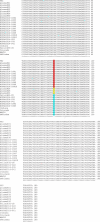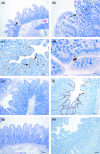Investigation into the role of potentially contaminated feed as a source of the first-detected outbreaks of porcine epidemic diarrhea in Canada
- PMID: 25098383
- PMCID: PMC4282400
- DOI: 10.1111/tbed.12269
Investigation into the role of potentially contaminated feed as a source of the first-detected outbreaks of porcine epidemic diarrhea in Canada
Abstract
In January 2014, approximately 9 months following the initial detection of porcine epidemic diarrhea (PED) in the USA, the first case of PED was confirmed in a swine herd in south-western Ontario. A follow-up epidemiological investigation carried out on the initial and 10 subsequent Ontario PED cases pointed to feed as a common risk factor. As a result, several lots of feed and spray-dried porcine plasma (SDPP) used as a feed supplement were tested for the presence of PEDV genome by real-time RT-PCR assay. Several of these tested positive, supporting the notion that contaminated feed may have been responsible for the introduction of PEDV into Canada. These findings led us to conduct a bioassay experiment in which three PEDV-positive SDPP samples (from a single lot) and two PEDV-positive feed samples supplemented with this SDPP were used to orally inoculate 3-week-old piglets. Although the feed-inoculated piglets did not show any significant excretion of PEDV, the SDPP-inoculated piglets shed PEDV at a relatively high level for ≥9 days. Despite the fact that the tested PEDV genome positive feed did not result in obvious piglet infection in our bioassay experiment, contaminated feed cannot be ruled out as a likely source of this introduction in the field where many other variables may play a contributing role.
Keywords: porcine epidemic diarrhea; spray-dried porcine plasma; transmission.
© Her Majesty the Queen in Right of Canada 2014 Transboundary and Emerging Diseases. Reproduced with the permission of the Minister of Agriculture and Agri-food and Minister of Health.
Figures



References
-
- CFIA News Release 18 February 2014, CFIA statement on porcine epidemic diarrhea virus in feed. Available at http://www.inspection.gc.ca/animals/terrestrial-animals/diseases/other-d... (accessed March 4, 2014).
-
- Chen, Q. , Li G., Stasko J., Thomas J. T., Stensland W. R., Pillatzki A. E., Gauger P. C., Schwartz K. J., Madson D., Yoon K.‐J., Stevenson G. W., Burrough E. R., Harmon K. M., and Main R. G., 2014: Isolation and characterization of porcine epidemic diarrhea viruses associated with the 2013 disease outbreak among swine in the United States. J. Clin. Microbiol. 52, 234–243. - PMC - PubMed
-
- Debouck, P. , and Pensaert M., 1980: Experimental infection of pigs with a new porcine enteric coronavirus, CV 777. Am. J. Vet. Res. 41, 219–223. - PubMed
-
- Ferreira, A. S. , Barbosa F. F., Tokach M. D., and Santos M., 2009: Spray dried plasma for pigs weaned at different ages. Recent. Pat. Food. Nutr. Agric. 1, 231–235. - PubMed
MeSH terms
Associated data
- Actions
- Actions
- Actions
- Actions
- Actions
LinkOut - more resources
Full Text Sources
Other Literature Sources
Medical
Research Materials

